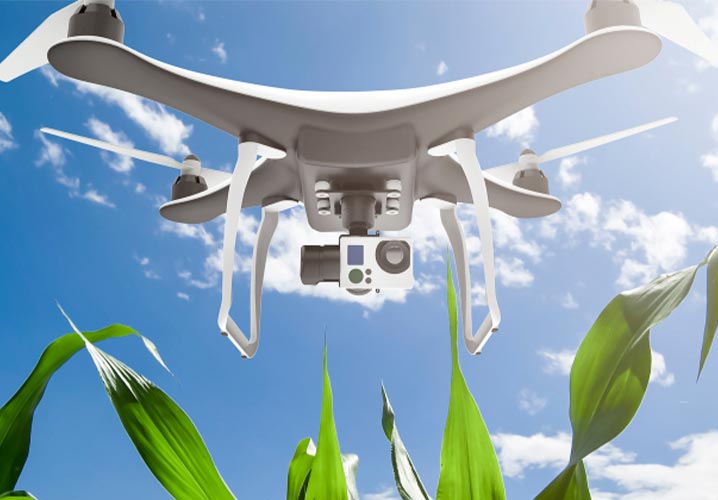
Helpers in the sky
These days, drones with camera technology are already part of day-to-day working life. New application areas can be found in logistics, for example – despite strict rules of operation.
Three years ago, a resident of Holzkirchen in Upper Bavaria sued a neighbouring farmer. He and his wife were unable to sleep at night because the cowbells were so loud. The farmer argued that the bells were tradition – and moreover, they made it easier to find cows that ran away. But why go chasing after a cow yourself when you can locate it with modern aeronautical technology – and make hardly any noise in the process? Increasingly frequently, farms are using drones to keep herds together. The unmanned aerial vehicles (UAVs), as they are technically called, also have other useful aspects: from the air, their cameras determine harvesting times or fertilise the fields.
Definition: UAV (commonly known as a drone)
A UAV (unmanned aerial vehicle) is an aircraft without a human pilot on board, steered by a remote control or computer. UAV is also the legally correct term for drones in commercial use.
‘In many business fields these days, drones are an integrated part of the company’s day-to-day operations,’ reports Dr Alexander Skorna, Business Development Manager at Funk. In addition to the familiar bird’s-eye exhibition photos, they are also used to service industrial systems and transport routes, for example. Moreover, as flexible measurement and visualisation tools, UAVs are used on large construction sites, as well as by the insurance sector as a practical aid during damage inspections.
Strict rules of flight operation
The use of unmanned aerial vehicles in Germany is governed by strict rules, however, which have been set out in the Drones Ordinance since 2017. In both commercial and private sectors, unmanned aerial vehicles with a take-off weight of 0.25 kg or more must be tagged; the operator must affix a badge to the UAV with their name and address. UAVs weighing 2 kg or more also require flight skills certification, and those weighing 5 kg or more additionally require a flight permit from the aviation authorities. This is also a requirement for flights at altitudes over 100 metres and for operations out of the visual range of the operator. And finally, liability insurance is compulsory for the use of drones, in order to protect against the rising risks of a collision. There were already 131 collisions reported between UAVs and other aircraft in 2018; in the year prior there were 88.
In Germany, there are wide-ranging flight bans to prevent such incidents. UAVs are not permitted to fly over sensitive areas such as residential complexes, industrial facilities, the premises of higher federal authorities or controlled airspace around airports. As a result, the commercial use of UAVs is heavily impeded. For example, since as early as 2014, DHL has been testing its ‘parcelcopters’, but as of yet they are still not in active use. Despite these obstacles Dr Alexander Skorna believes there is a future for UAVs: ‘Drones have the potential to redefine our mobility – like the car did in the last century.’ And it’s not just logistics companies that are conducting research in this field; enterprises like Airbus are also investigating the possibilities In this case, the drone transforms from a flexible camera to a ‘flying taxi’ – demonstrating just one of the many potential innovative applications of the UAV in the commercial world of tomorrow.
The resident in Upper Bavaria has a less positive view of the future, however, because the cows there are still wearing bells. But perhaps a food delivery will cheer him up – arriving, of course, by drone. In China, at least, this application is already a reality.
Flying the skies without risk: an overview of drone insurance policies
Liability insurance
- Aeronautical liability insurance is compulsory under German law; a certificate must be on hand at all times.
- In individual cases, public liability insurance may be applicable, but usually a separate policy is needed.
- Most offers include an open operator clause, i.e. an unlimited amount of users. Extra insurance is required, however, if the drone is to be leased out.
- Insurance cover is only valid if legal provisions and stipulations from the authorities are observed.
Fully comprehensive insurance
- Fully comprehensive insurance is voluntary and can be taken out in order to protect the UAV itself.
- Damage to smaller drones is often already covered by existing electronic equipment insurance.
- Fully comprehensive insurance covers crashes over land (including those caused by operator error). In the commercial sector, damage to accessories or transport damage and theft can also be covered.
- Drone defects caused by crashes into water, weather conditions or amateur repairs are not covered.
10/05/2019
Your point of contact


